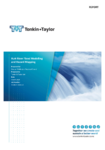Hutt River Flood Modelling and Hazard Mapping
Search in document library
Purpose of the report:
To update and improve flood modelling for the Hutt River to support flood risk management, planning, and LIM reporting under current and future climate conditions.
Geographic area covered:
The report covers the Hutt River catchment from the Stuart Macaskill Lakes (north of Upper Hutt) to Wellington Harbour at Petone, including Upper Hutt, Lower Hutt, Wainuiomata, and the Porirua Basin.
Summary:
This report presents an updated flood model for the Hutt River, developed by Tonkin & Taylor Ltd for Greater Wellington Regional Council (GWRC). The model combines previous Upper and Lower Hutt models into a single 1D-2D hydraulic model (ULHH_202207_V054) using MIKE by DHI software. It covers approximately 139 km² and includes updated topographic data, river cross-sections, flood defences, and infrastructure such as bridges and culverts.
The model simulates a wide range of flood scenarios, including design storms with various Annual Exceedance Probabilities (AEPs), stopbank breach events, and climate change impacts. Climate change scenarios include a 20% increase in river inflows and 1 metre of sea level rise. The model outputs include flood extents, depths, velocities, and hazard classifications using the Australian Rainfall and Runoff (ARR) six-class system (H1–H6).
Key findings show that flood levels and velocities increase with rarer events (lower AEPs), higher flow rates, and climate change. For example, under a 2% AEP event with climate change, upstream water levels can reach over 84 mRL, and velocities can exceed 6.8 m/s in some reaches. Stopbank breach scenarios show significant increases in flood extent and depth in protected areas. Areas benefitting from flood defences were also identified by simulating the removal of stopbanks.
The model was peer-reviewed by Awa Environmental Ltd and underwent multiple updates between 2020 and 2023. Improvements included better file structure, updated cross-sections, refined bridge and stopbank representation, and removal of unnecessary parameters. While the model is robust for in-channel and stopbank overtopping assessments, it is less reliable for detailed urban floodplain hazard due to coarse resolution and limited drainage detail.
The report includes detailed tables of maximum water levels and velocities along the Hutt River, referenced to the WVD-53 vertical datum. These results are suitable for use in LIM reports, infrastructure design, and floodplain management. Climate change consistently increases water levels by 0.3–0.5 m and velocities by 0.2–0.4 m/s across all scenarios.
For LIM purposes, the report provides site-specific flood hazard information, including expected maximum water levels and velocities for a range of flood scenarios. It highlights that properties near the river may face increased flood risk in the future due to climate change. While the model has some limitations, it is considered fit for purpose as of March 2023 and provides a reliable basis for flood risk communication and planning.
